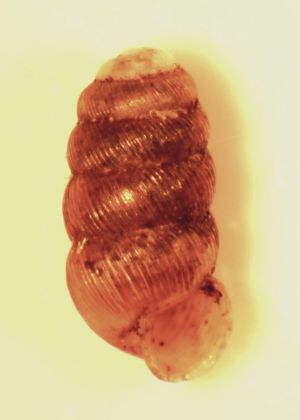|
The Vertiginid Truncatellina cylindrica (figure 1) is a very rare snail in the UK. It was formerly more common, but since the middle of the 20th century it has declined in the UK almost to the point of extinction. According to Michael Kerney (1999) there were only three remaining sites for living populations of T. cylindrica in the UK. The three sites were at Potton (Bedfordshire), Went Vale (Yorkshire) (Norris, 1976) and at Thetford (Norfolk) (Davis, 1952). There have been recent surveys carried out by Adrian Norris who has confirmed that the species is still living at the Yorkshire site. There has also been a recent survey carried out by Peter Topley (June 2010) who has confirmed the finding of a few dead shells at the Potton site, which indicates that the species could still be surviving there, despite the re-pointing of an adjoining wall a few years ago and a recent overgrowth of vegetation. However, I was informed in 2008 that the species is no longer living at the Norfolk site where it was recorded in 1952 at Two Mile Bottom on the Mundford road a few miles from Thetford. Studies of the Ordnance Survey map of the area show the the original site has almost certainly been consumed by pine forest plantation. In 2005 Dave Charlton and the author carried out searches for T. cylindrica at Barnham Cross Common near Thetford, Norfolk. Having gained experience of finding tiny Vertiginids in the field previously that year, our method of searching for this species was to attempt to see the shells in their habitat without taking soil samples. Searches were carried out wherever there was loose soil on short-turfed ground at various parts of the Common. This search proved to be unsuccessful. In May 2006, Craig Ruscoe and the author spent two weeks collecting shells in Halkidiki, Greece. Here on a roadside bank we found several dead shells of T. cylindrica. The shells were found in loose soil under the roots of shrubs on very short grass on a steep bank facing away from a main road. In June 2006, together with Dave Charlton, we carried out further surveys at Barnham Cross Common. Craig noticed a ditch filled with nettles and other weeds running adjacent to the main road near the Common car park (figure 2). On sifting through the loose soil on the bank I found my first specimen of T. cylindrica here. About 15 dead shells were found in total. The soil at this site consists of many tiny stones and could almost be described as sandy. The grass here is kept very short through grazing by rabbits. In July 2010, a third survey was carried out at the site. On this occasion we were also accompanied by David Hutchinson, like us a British Shell Collectors’ Club member. The habitat had dried out considerably. Most of the vegetation on the top of the ditch was withered. However, some healthy vegetation remained in small patches where the ground had retained enough moisture. Soil samples were taken from these patches at the top of the ditch in an attempt to find fresh dead shells. In excess of 70 specimens were found in the samples, many of them fresh. Eleven live specimens were found in the samples, proving that the species is still surviving here in reasonable numbers. Other snails found here included Pupilla muscorum, Cecilioides acicula, Punctum pygmaeum, Vertigo pygmaea, Vallonia excentrica, Vallonia costata, Candidula intersecta and Monacha cantiana, although very few live snails were observed at the site. The snails should continue to survive here as long as the habitat is not destroyed. Threats to the habitat here include extreme drought, pollution, the use of pesticides, herbicides etc. It is possible that T. cylindrica could be living at other similar sites in the area. However as the area continues to be cultivated and planted with pine trees, the survival of this rare snail in the Thetford area has to be considered under major threat. Reference: Kerney,M (1999) Atlas of the land and freshwater molluscs of Britain and Ireland.Harley Books, Essex |
 figure 1: Truncatellina cylindrica (height 1.8mm) (photo:Peter Topley) figure 1: Truncatellina cylindrica (height 1.8mm) (photo:Peter Topley)
|
Truncatellina cyclindrica – a rare snail at a Norfolk Common
Issue
24
Page
26
Species
